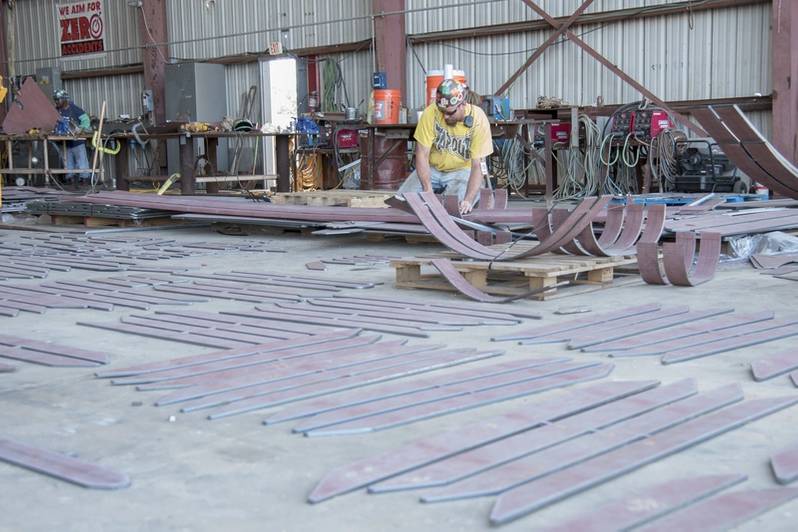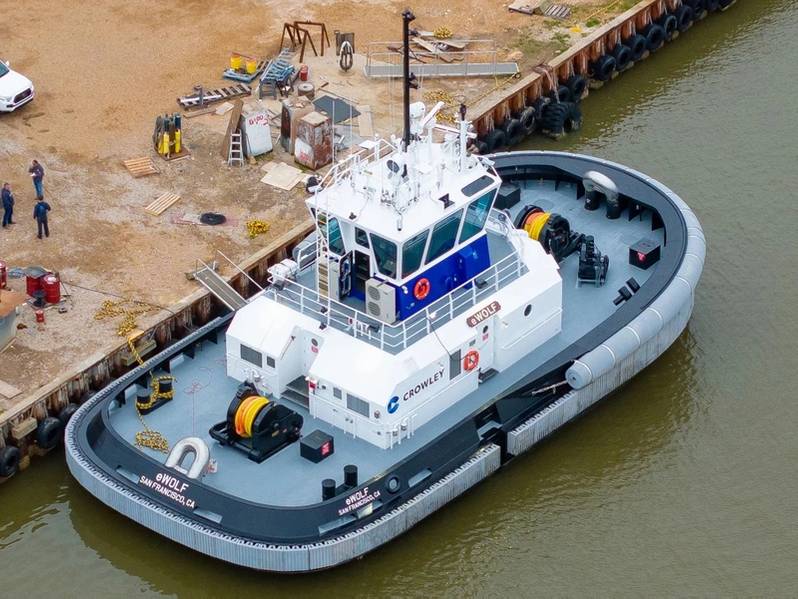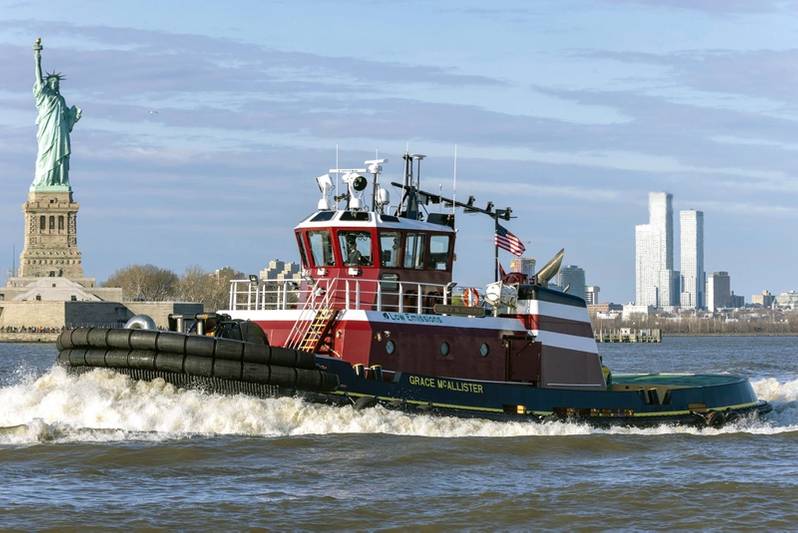Marine News' 2024 US Shipbuilding Report
If nothing else, building vessels in the U.S. is a complicated business.
In a session on the domestic shipbuilding marketplace, at Marine Money’s late-November 2023 conference held in New Orleans, Ben Bordelon, president and CEO of Bollinger Shipyards (with more than a dozen facilities, in Mississippi and Louisiana), described his company’s architecture as a “three-legged stool approach: commercial newbuilds, government newbuilds and repair/conversion capabilities”.
On the same panel, moderated by Roy Bleiberg, who handles Business Development, North America, for ABS, Joey D’Isernia, the chairman and CEO of Eastern Shipbuilding Group (with three yards in the Florida Panhandle), handling “…government and commercial work, primarily newbuilds, but also repairs,” talked about the balance between government versus private-sector work for U.S. yards. He noted the extreme cyclicality of commercial work, saying, “It’s extremely challenging to recruit, train and sustain a workforce” with all the ups and downs, and described the yard’s moves into to government work. “It was really about providing a good and steady base for riding out those cycles,” he said.
Highlighting his yard’s successes with work for the U.S. Coast Guard in construction of Offshore Patrol Cutters (OPC), D’Isernia stressed the challenges of doing both government and commercial work (historically, the yard’s focus), which require very different business systems to be in place. “We’ve been able to do both,” he said, noting that having systems in place for government jobs makes Eastern Shipbuilding “move-in ready for the Navy and other DOD agencies that are going to have to grow the fleet.”
“The big challenge,” D’Isernia said, “is that there is not enough capacity in the U.S. . . . We are certainly eager to expand our presence in the government marketplace.”
 Eastern Shipbuilding Group is building the first four Offshore Patrol Cutters for the U.S. Coast Guard (Photo: Loumania Stewart / U.S. Coast Guard)
Eastern Shipbuilding Group is building the first four Offshore Patrol Cutters for the U.S. Coast Guard (Photo: Loumania Stewart / U.S. Coast Guard)
In the same panel discussion, Bollinger’s Bordelon said, “You’ve had vessels come out of typical oil and gas markets and maneuver into other markets. This creates conversion opportunities. We’ve probably done over 30 in the last couple of years.” But with stronger oil and gas markets (seemingly) on the horizon, he wondered aloud whether such work might continue on a bigger scale.
Two 2024 announcements from Eastern Shipbuilding provide a window into the types of commercial projects that sophisticated yards can take on. It announced a deal with a financial owner (which acquired the partially completed vessels after difficulties at another yard) to finish construction of two ultra-high-spec 400 class multipurpose support vessels (MPSV) for Hornbeck Offshore Services. According to Eastern, HOS Warhorse and HOS Wild Horse will boast two large, heave-compensated cranes, two remotely operated vehicles (ROV), a spacious moonpool and accommodations for 102 personnel.
In another project for Hornbeck, the yard is undertaking the conversion of a 2014 built 280 class Platform Supply vessel into a high spec Service Operation Vessel (SOV), to be named HOS Rocinante. Eastern says that the converted vessel, set for Spring 2025 delivery, “is a dual-service SOV/flotel tailored to serve the emerging demand of the U.S. offshore wind market and the ongoing demand of the petro-energy flotel market.” Not so coincidentally, the boat (ex-name HOS Rosehill) was originally built by Eastern.
On the Marine Money panel in New Orleans, Bollinger’s Bordelon had a different take on cyclicality, noting the absence of supply vessels under construction, as the market is recovering from the huge dip staring in 2014-2015. Like Eastern Shipbuilding, Bollinger handles both government and commercial work, and also strives to keep them separate. Bordelon was quick to point that: “The government does have some complex ships, and there are some lessons learned as far as project management, engineering and procurement that you can integrate into commercial applications.”
Bordelon followed up, discussing consolidation in the sector, noting “the smaller pool” and citing Bollinger’s acquisitions of Gulf Island Shipyard (2021) and Halter (2022). He said, “Staying in commercial keeps your blades sharp. . . It is a more competitive market.” In describing its portfolio, Bordelon cited the yard’s present government-heavy newbuilds posture, saying, “We like more complex projects, that have more added value.”
Complexity also ties into the human resources side of the business, a perennial issue for yards, with both panelists emphasizing the need to “de risk” projects early on. This includes detailed management of workflows, where the specific tasks comport with the skills and expertise of the workforce.
“We need it to be as easy as it can be for us to have success. . . We spent a lot of our time on front-end engineering,” Bordelon said, noting that in some cases, the need for highly specific skillsets has led to actual acquisition of vendors: “Sometimes we make buys.”
After mentioning one long-term program building Fast Response Cutters (FRC) for the Coast Guard, where 55 vessels have been delivered over three decades, Bordelon said, “I’m pretty vertically integrated on that contract.” This was then contrasted with commercial work, with one-off projects, he added: “It’s hard to staff up . . . because you don’t have the sustained backlog.”
Previous editions of Marine News’ U.S. Shipbuilding Report have noted the increasing concern about what ABS’s Bleiberg (moderating the Marine Money panel) called “the big push for sustainable” shipping”, adding that: “What we see is a substantial increase in retrofits and upgrades.”
New technologies can require new construction. Indeed, sustainability concerns are behind two innovative newbuilds: eWolf, an all-electric tug delivered to Crowley from Master Boat Builders (Coden, Ala.) in January 2024, and Hydrogen One, a towboat to be powered by a hydrogen fuel cell, under construction at Intracoastal Iron Works in Bourg, La. The vessel will join the fleet of financial owner Maritime Partners, who have placed it on a long-term charter to a leading inland tug and barge operator.
The electric tug illustrates a different form of the complexities, with numerous external regulatory and financial “stakeholders” surrounding such newbuilds, and going way beyond the technologies (using a energy storage system from Corvus Energy, feeding an electrical propulsion package from ABB, driving a pair of Rudder Propellers from Schottel). In a news release, Crowley notes that the new tug “represents a historic innovation through a collaboration among Crowley, federal, state and local government partners. Their mutual commitment to improve air quality through battery energy for the vessel and port technology, including a shoreside, microgrid charging and storage station at the Port of San Diego.”
 Crowley's electric tug eWolf, built by Master Boat Builders (Photo: Crowley)
Crowley's electric tug eWolf, built by Master Boat Builders (Photo: Crowley)
The Maritime Partners tug (with its hydrogen fuel cell fed from a methanol reformer), architected by Elliott Bay Design Group, and originally slated for a 2023 delivery, is now scheduled for 2024 delivery.
Master Boat Builders is also constructing more conventional vessels. In mid-2023, it announced an order for two 92-foot escort tugs, with design by Robert Allan, Ltd. to be built for Moran Towing, based in Connecticut. Though using conventional fuel, the boats will feature Caterpillar 3516 EPA Tier 4 main engines. The yard is also building two smaller 86-foot tugs for Moran Towing, also set to handle ship assist along the East Coast, ordered the previous year.
McAllister Towing, based in downtown New York, took delivery, in late 2023, of sister vessels Jane McAllister and Grace McAllister, from the Washburn & Doughty shipyard, in Maine. The Z-drive tugs also seature Tier 4 main engines from Caterpillar. Another in the series, Isabel McAllister, will be delivered in 2024.
 Grace McAllister, one of three sisters from Washburn & Doughty (Photo: McAllister Towing)
Grace McAllister, one of three sisters from Washburn & Doughty (Photo: McAllister Towing)
Construction of new vessels for the offshore wind markets has fallen short of the boom times forecast only several years ago amid calls for “30 by 30” (30 gigawatts (GW) of offshore power generated by 2030). At a February 2024 New York event hosted by Hellenic American and Norwegian American Chambers of Commerce (the HACC NACC conference), Charlie Papavizas, partner at law firm Winston Strawn appearing on an offshore wind panel, expressed concern about “the bad news”—cancellations of widely touted wind projects in the U.S. Northeast.
On the same HACC NACC panel, Alexandra Tebaldi, from MacAllister Towing, citing a recent conversion with an industry trade group, said, “The expectation is that we will reach half of our goal by 2030: 14.5 GW. . . The goal stays alive, but we have to find a way forward from here.”
Wind-related newbuild activity has been limited by the short-term nature of contracting. On the same panel, Papavizas said, “Most of the vessels have to be built on spec”, and added that “they are not getting term contracts, except for service operations vessels (SOV).”
Tebaldi estimated the current cost for contracting a Jones Act compliant SOV at around $180 million.
Two SOVs, contracted in 2022, are presently under construction at Edison Chouest facilities. ECO Edison, an SOV (set to support Ørsted and Eversource projects Revolution Wind, South Fork Wind and Sunrise Wind) is under construction at its Houma, La. facility. Filings with the U.S. Maritime Administration (MARAD) put a cost of $97 million on the vessel. The same yard has also been contracted to build an SOV with hybrid power capability (at a cost of $109 million per MARAD) to be deployed at the Equinor/ BP Empire Wind projects. Fincantieri Bay Shipbuilding, in Sturgeon Bay, Wis., is building an SOV (with a pricetag of $168 million, per MARAD) for CREST Wind, a joint venture of U.S. stalwart Crowley Maritime, and the Danish offshore specialist Esvagt. Scheduled to be delivered in 2026, the vessel (with a Norwegian design proven in the North Sea) will enter a long-term charter to turbine specialist Siemens Gamesa Renewable Energy. Dominion Energy, the Virginia utility developing the 2.6 GW Coastal Virginia Offshore Wind (CVOW) project, is bringing in a capital infusion from alternative investor StonePeak Infrastructure Partners.
Philly Shipyard, a builder of deepsea Jones Act vessels, has been a beneficiary of the move to offshore wind, cutting steel in mid-2023 on a rock installation vessel to be named Acadia, contracted by Great Lakes Dredge & Dock (GLDD) for loading rock in upstate New York for use in protecting monopiles (foundations for wind turbines) and undersea wiring on the sea floor. According to GLDD regulatory filings, the vessel “is expected to be delivered and operational in 2025.” Filings with MARAD (which could potentially approve Title XI funding, meaning lengthier terms and lower interest rates, for vessels serving offshore wind) indicate a total cost of $246.7 million.
 Rock installation vessel Acadia is being built by Philly Shipyard for Great Lakes Dredge & Dock Company. (Image: Ulstein)
Rock installation vessel Acadia is being built by Philly Shipyard for Great Lakes Dredge & Dock Company. (Image: Ulstein)
GLDD is also supporting U.S. yards, with two suction hopper dredges equipped with U.S. EPA Tier 4 compliant engines: Galveston Island, which was delivered from Conrad Shipyard in late 2023 (and is working on a multi-year harbor deepening project in Freeport, Texas), and Amelia Island, being constructed by the same shipyard for a 2025 delivery date.
The offshore wind sector has seen a number of contracts for crew transfer vessels (CTV). St. Johns Ship Building in Palatka, Fla. announced a contract with Windea CTV LLC., a U.S. domiciled joint venture between the U.S.-based MidOcean group, and passenger vessel owner Hornblower, with German CTV specialist Ems Maritime Offshore GmbH providing technical and operational support. MARAD filings put the price of the 10-vessel construction program at $120 million. The yard, which under new ownership has revamped its facilities, has recently delivered WINDEA Courageous, the first of three CTVs for an earlier contract with Windea CTV LLC.
Other shipyards known to be building CTVs at the moment include Blount Boats and Sensesco Marine, both in Rhode Island, as well as Metal Shark, Breaux Brothers and Gulf Craft in Louisiana and Gladding-Hearn Shipbuilding in Massachusetts. Port Angeles, Wash. shipyard Platypus Marine is building a CTV on spec.
Work continues at Seatrium AmFELS (formerly Keppel AmFELS), in Brownsville, Texas on Charybdis, the sole Jones Act compliant wind turbine installation vessel (WTIV) under construction in the United States. The most recent announcements have put the WTIV’s cost at $625 million, with delivery pushed back to late 2024/early 2025.
 Senesco Marine is building a series of crew transfer vessels for sister company WindServe Marine, including the WindServe Journey launched in 2023. (WindServe Marine)
Senesco Marine is building a series of crew transfer vessels for sister company WindServe Marine, including the WindServe Journey launched in 2023. (WindServe Marine)
This article originally appeared in the April 2024 edition of Marine News magazine.

















